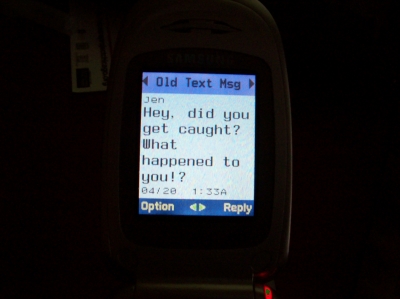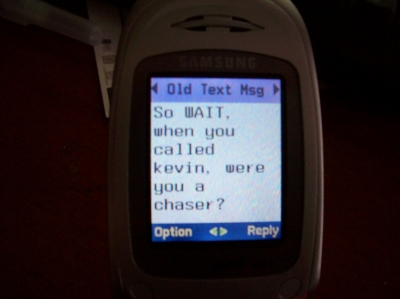Journey to the End of the Night Chicago by MsGoblinPants Extraordinaire
July 16th, 2010 4:34 PM / Location: 41.850033,-87.65005First mentioned in a monograph by noted scientist Edgar Allen Poe, the red death was feared for the speed with which is stuck, and the inevitably fatal results of infection. The first and only symptom of the disease was described by Poe as “scarlet stains upon the body”. Later observers mention seeing “a flash of red” or “a band of red around one arm.” According to contemporary scientists, simply touching someone who had a red band was enough to become infected. The disease spread so quickly that the infected rapidly became known as “Chasers,” while those still healthy referred to themselves as “Runners.” Cities with large populations and airports were particularly hard hit: San Francisco, Chicago, even Minneapolis suffered from infections that swept the populace.
A manuscript detailing an encounter with the Red Death was recently recovered from an early human-era “intarweb.” Footnotes are attached to explain obscure references.
"Last night was Journey to the End of the Night (1), which was fantastically fun for the first hour and then not so much for the rest of the night (2). We started out from Wicker Park in a big pack which got progressively smaller as the various sprints, alley-ways and panic split us into smaller and smaller groups. I only made it to the first checkpoint (3). On our way to the second, we saw that there were clumps of Chasers (4) everywhere. We hid behind a series of parked cars, but the Chasers spotted us and our collective nerve broke (5). As a pack, we ran for safety--but it proved a poor strategy for many of us. I got tagged after a harrowing sprint, which pretty much ended the game for me (6). Kylleran, H. and I spent the next three hours wandering the city and making half-hearted attempts to Catch the remaining Runners. While trying to get to the fifth checkpoint, we stumbled upon a muddy and pee-scented construction site that seemed ripe for the appearance of a monstrous mutant alien creature (7). There was no way to escape the blasted site except to climb up a story or two onto the highway--or turn back. Turn back we did, luckily avoiding any mutants. Finally, footsore (8) and loserpantsed, we stumbled to Gremlinski’s party and awaited the return of those who had managed to complete the game."
1. Outbreaks of the Red Death are commonly referred in this oblique fashion. The most widely accepted explanation for this is that using euphemisms allowed the human populace (at this time in history, Dolphinborgs, robots, and the Ever-Changed were not part of sentient life on Sol3) to remain calm in times of extreme emotional stress.
2. This is undoubtedly another instance of the utilization of understatement to post-pone a nervous breakdown.
3. Checkpoints were areas at which those running from the Red Death could consider themselves momentarily safe from infection. Many theorize that they were pitifully inadequate medical centers, although why "cupcakes" would be repeatedly mentioned in regards to the first checkpoint in Chicago remains a mystery.
4. Based upon this text and the short message found elsewhere (see attached image), I theorize that those infected with the Red Death not only inadvertently spread the disease, but in fact sought to do so. Their motivations remain unclear--perhaps the disease caused damage to the information processing centers (called "brains" by humans of the era).
5. "collective nerve" is, I believe, not a factual statement but a fanciful one. There is no evidence to suggest that humans at this time had achieved even rudimentary Hive minds, let alone the sophisticated telepathic networks we rely upon in contemporary society.
6. "ended the game for me" is another example of an understatement to keep up morale. The "game" that the author refers to as ending is undoubtedly hir life. There are no records of a cure for the Red Death.
7. Several of my colleagues' abstracts have used this sentence as proof that the Ever-Changed were already known to human society in the pre-Singularity era. I believe that this is another fanciful statement on the part of the author.
8. Humans of this era had not yet invented what we today consider rudimentary assistive technology. Hoverbelts, teleportation rings, even the casual removal of body parts--none were yet possible. It was a dark and grim time to be a sentient life-form.
Message to a loved one beset by the Red Death

Contrary to the opinion of fellow researchers into this era, it is my belief that humans did in fact experience emotions pre-Singularity. The double punctuation at the end of this "text message" would have conveyed a tone of concern or even worry to people of the time.
Subterfuge and lies.

It is a matter of historical record that pre-Singularity humans were capable of lying. Although this message provides further proof of their capability, it also has a darker lesson for historians. Clearly, some of those afflicted with the Red Death sought to hide their affliction, or even (most disturbing of all) infect others with it.
12 vote(s)

rehsamsevoL Lovesmasher
5
Dela Dejavoo
5
Julian Muffinbot
5
Amby D
5
Ombwah
5
Zenobia
5
LittleMonk
5
Spidere
5
Togashi Ni
5
Indy
5
carry_me_Zaddy
5
PsyDlocke












 A pursuit across Chicagø in 6 parts, staged on the night of April 19th, 2008.
A pursuit across Chicagø in 6 parts, staged on the night of April 19th, 2008.